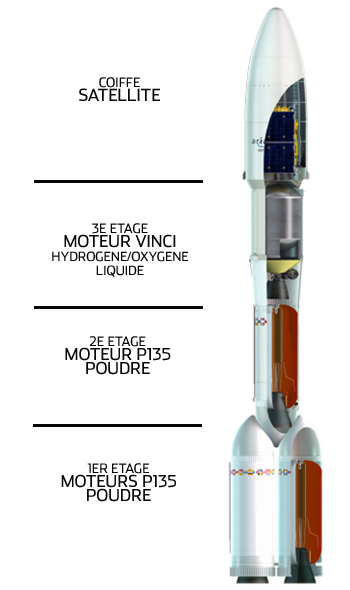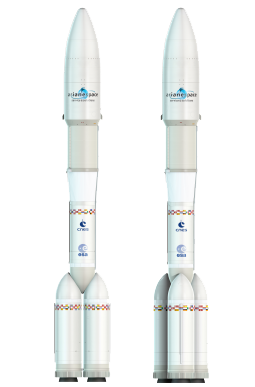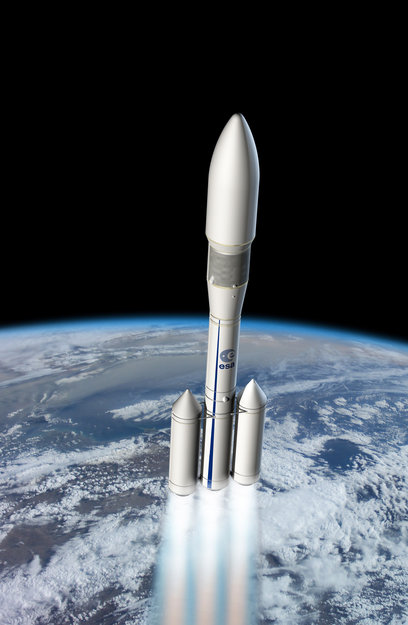.
11.03.2013

Envisioned configuration of the future Ariane 6. Credits: ESA/CNES/Arianespace.
.
Europe sets its sights on Ariane 6
.
Last November in Naples, ministers in charge of European space policy gave their blessing for a new Ariane 6 launcher designed to help Europe stay ahead in the satellite launch services market.
.
Ariane 6 will launch a single satellite at a time
.
Ariane 5 is the leader in the global telecommunications satellite market, launching 10 satellites every year. But with satellites getting ever heavier, it is proving harder to match dual launches to the vehicle’s 9.4-tonne lift capacity. At the same time, its competitors are not standing still…
The Russians are currently the main competitors with their Proton launcher, Ukraine’s Zenit vehicle is operational again—albeit after a series of setbacks—and China’s Long March could be a new entrant by 2020,” says Joseph Berenbach, Deputy Director of Forward Planning, Research and Technology at CNES’s Launch Vehicles Directorate. “All these factors are likely to erode Ariane’s market share.”
The European Space Agency (ESA), backed by CNES, therefore decided to respond to this challenge with a launcher tailored to future market requirements. In other words, a launcher capable of orbiting commercial satellites weighing up to 6.5 t or smaller institutional satellites, sustaining a rate of 3 to 4 launches a year at a competitive price by 2021.
Ariane 5 is hamstrung by the need to find 2 satellites ready to launch every 2 to 3 months and compatible with its lift performance,” notes Joseph Berenbach. “On the other hand, Ariane 6 will launch a single satellite at a time, so it will be much more flexible and responsive: customers will no longer have to wait to launch their spacecraft.
-

Two possible configurations for the 1st stage of the future Ariane 6, with 2 or 3 boosters. Credits: ESA/CNES/Arianespace.
.
Two solid stages, one liquid stage
.
Since 2009 and the report commissioned by then Prime Minister François Fillon, European engineers and manufacturers have been hard at work on the new launcher. Over 100 concepts were studied before deciding on a 3-stage PPH configuration.
The PPH configuration will comprise 2 solid-booster stages and a 3rd liquid hydrogen and oxygen stage, like the current Ariane 5,” explains Joseph Berenbach. The thinking behind this decision is basically that solid boosters can be series-produced economically while the upper cryogenic stage engine will significantly enhance the launcher’s performance.
Ariane 6’s 1st stage will consist of 2 or 3 solid boosters so it can adapt to launch heavier or lighter satellites,” adds Joseph Berenbach. “This multi-solid concept developed with our industry partners Astrium, Herakles and Snecma is completely new.
Ariane 6 is scheduled to make its first flight in 2021. Before then, engineers will be working to develop a particularly powerful reignitable final stage for Ariane 5 in 2018 and ultimately for the new Ariane 6 in 2021.
.
Quelle:CNES
.
Update: 14.11.2013
.

ARIANE 6 MOVES TO NEXT STAGE OF DEVELOPMENT
.
The preliminary requirements for Europe’s next-generation Ariane 6 launcher have been agreed and the project is set to move on to the next stage.
In November 2012, the ESA Council at Ministerial level, meeting in Naples, Italy, approved the start of preparatory activities for Europe’s next-generation Ariane 6 launch vehicle.
The objective of Ariane 6 is to guarantee autonomous access to space for Europe, serving European institutional missions, without requiring public support to exploit.
The performance requested for the new vehicle is up to 6.5 tonnes in equivalent geostationary transfer orbit, to cover both institutional and commercial needs. The configuration retained was ‘PPH’ – indicating the sequence of stages: a first and a second stage using solid propulsion (P) and a third stage using cryogenic propulsion (H).
Ministers also requested that the new vehicle exploits maximum commonalities with the cryogenic reignitable upper stage of Ariane 5 ME.
In early July, seven months after ESA’s Ministerial Council decision, the concept for the Ariane 6 vehicle was selected.
On 1 October the Preliminary Requirements Review of the launch system began. The management plans and the preliminary specifications together with the technical and programmatic files of the concept were submitted for review.
The review was concluded by the board on 6 November. The review involved European experts from Arianespace, Italy’s ASI space agency, France’s CNES space agency, the DLR German Aerospace Center and ESA. European customers also participated and contributed to the consolidation of the Mission Requirement Document, which will drive the development.
The next step for the Ariane 6 project is the completion of a first Design Analysis Cycle, which is planned for the end of February, and which includes trade-offs for several subsystems. A second Design Analysis Cycle will start in March. The results of the second loop will feed the next ESA review: the System Requirements Review, planned for October–November 2014.
In parallel, ESA has consulted industry to gather competing ideas on key launcher elements. More than 160 responses were received, and ESA is completing their evaluation. This will allow the progressive setting up of the industrial organisation, awarding contracts to subcontractors for the second Design Analysis Cycle and receiving an industry proposal for the full development of Ariane 6 in preparation for the next ESA Ministerial Council meeting.
“Decisions taken by the ESA Council at Ministerial level in November 2012 are being implemented strictly and timely,” noted Antonio Fabrizi, ESA’s Director of Launchers.
Quelle: ESA
6700 Views
